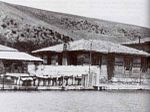Silahtarağa Power Station
1914 establishments in the Ottoman EmpireBuildings and structures in IstanbulCoal-fired power stations in TurkeyEnergy infrastructure completed in 1914Golden Horn ... and 4 more
Istanbul Bilgi UniversityMuseums in IstanbulRedevelopment projects in IstanbulTechnology museums in Turkey

The Silahtarağa Power Station (Turkish: Silahtarağa Elektrik Santralı) was a coal-fired generating station located in Istanbul Turkey. The Ottoman Empire's first power plant, it was in use from 1914 to 1983. The site has since been converted into a university campus for the Istanbul Bilgi University and houses two museums and several facilities. It was refurbished and renamed SantralIstanbul in 2007.
Excerpt from the Wikipedia article Silahtarağa Power Station (License: CC BY-SA 3.0, Authors, Images).Silahtarağa Power Station
İstanbul Bilgi Üniversitesi İç Yolları,
Geographical coordinates (GPS) Address Nearby Places Show on map
Geographical coordinates (GPS)
| Latitude | Longitude |
|---|---|
| N 41.067222222222 ° | E 28.945833333333 ° |
Address
İstanbul Bilgi Üniversitesi Santral Kampüsü
İstanbul Bilgi Üniversitesi İç Yolları
34060
Türkiye
Open on Google Maps






